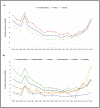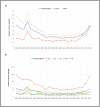Annual trends of hepatitis C virus infection in Manitoba between 1998 and 2018: A focus on special populations
- PMID: 37503521
- PMCID: PMC10370720
- DOI: 10.3138/canlivj-2022-0030
Annual trends of hepatitis C virus infection in Manitoba between 1998 and 2018: A focus on special populations
Abstract
Background: Hepatitis C virus (HCV) infection is a major cause of liver-related morbidity and mortality worldwide. Epidemiological data of HCV infection in the Canadian province of Manitoba are limited.
Methods: A population-based retrospective study was conducted using data from the Manitoba Centre for Health Policy repository. Using the test results provided by the Cadham provincial laboratory, individuals in Manitoba with a diagnosis of HCV infection were identified. Annual prevalence and incidence rates (crude and standardized) were calculated for the overall population and stratified by sex, regional health authority (RHA), residence area, income quintile, and special population groups (children, older adults, and pregnant persons).
Results: A total of 8,721 HCV cases were diagnosed between 1998 and 2018 in Manitoba. Overall crude HCV incidence and prevalence were estimated as 0.03% and 0.37% during the study period, respectively. No significant change was observed in the standardized HCV incidence rate (per 100,000) during the study period (54.3 in 1998 and 54.8 in 2018). However, the standardized HCV prevalence (per 100,000) increased from 52.5 (95% CI 39.2-68.7) in 1998 to 655.2 (95% CI 605.9-707.3) in 2018. An overall average incidence rate based on sex, RHA, region, income, and special population groups was observed to be higher in males (40.1), Winnipeg RHA (42.7), urban region (42.3), low-income quintiles (78.5), and pregnant persons (94.3), respectively.
Conclusion: Although incidence rates of HCV infection in Manitoba appeared to have initially declined, rates showed an upward trend by the end of the study period while prevalence increased steadily.
Keywords: Manitoba; children; hepatitis C; incidence; older adults; pregnant persons; prevalence.
© Canadian Association for the Study of the Liver, 2023.
Conflict of interest statement
SK Gudi received funding from the Drug Safety and Effectiveness Cross-Disciplinary Training (DSECT) program, as well as meeting support from the Canadian Network for Observational Drug Effect Studies (CNODES). C Osiowy received registration and accommodation for the Canadian Liver Meeting 2022 in Ottawa for being a speaker at the meeting. S Alessi-Severini was awarded the Leslie F. Buggey Professorship, which supported the present manuscript. She also received consulting fees from Jupiter Research Inc.
Figures
Similar articles
-
A population-based study of the epidemiology of hepatitis C in a North American population.J Hepatol. 2012 Oct;57(4):736-42. doi: 10.1016/j.jhep.2012.05.018. Epub 2012 Jun 2. J Hepatol. 2012. PMID: 22668641
-
Epidemiological study of hepatitis B virus infection in Manitoba, Canada, 1992-2003.Eur J Clin Microbiol Infect Dis. 2005 Jul;24(7):464-70. doi: 10.1007/s10096-005-1350-6. Eur J Clin Microbiol Infect Dis. 2005. PMID: 15959814
-
Comparison of the epidemiology of laboratory-confirmed influenza A and influenza B cases in Manitoba, Canada.BMC Public Health. 2015 Jan 30;15:35. doi: 10.1186/s12889-015-1351-z. BMC Public Health. 2015. PMID: 25633280 Free PMC article.
-
Global Burden and Changing Trend of Hepatitis C Virus Infection in HIV-Positive and HIV-Negative MSM: A Systematic Review and Meta-Analysis.Front Med (Lausanne). 2021 Dec 13;8:774793. doi: 10.3389/fmed.2021.774793. eCollection 2021. Front Med (Lausanne). 2021. PMID: 34966758 Free PMC article.
-
Epidemiology of hepatitis C virus in Ghana: a systematic review and meta-analysis.BMC Infect Dis. 2016 Aug 9;16:391. doi: 10.1186/s12879-016-1708-7. BMC Infect Dis. 2016. PMID: 27507267 Free PMC article.
Cited by
-
Epidemiology of Hepatitis C over 28 years of monitoring Canadian blood donors: Insight into a low-risk undiagnosed population.BMC Public Health. 2024 Aug 27;24(1):2319. doi: 10.1186/s12889-024-19790-2. BMC Public Health. 2024. PMID: 39192303 Free PMC article.
References
-
- World Health Organization. Global hepatitis report, 2017. Geneva: World Health Organization [Internet]. Geneva: Switzerland; 2017. [cited 2022 May 5]. Available from: https://apps.who.int/iris/rest/bitstreams/1082595/retrieve
-
- Degenhardt L, Charlson F, Stanaway J, et al. Estimating the burden of disease attributable to injecting drug use as a risk factor for HIV, hepatitis C, and hepatitis B: findings from the Global Burden of Disease study 2013. Lancet Infect Dis. 2016;16(12):1385–98. 10.1016/S1473-3099(16)30325-5. Medline: - DOI - PubMed
LinkOut - more resources
Full Text Sources



